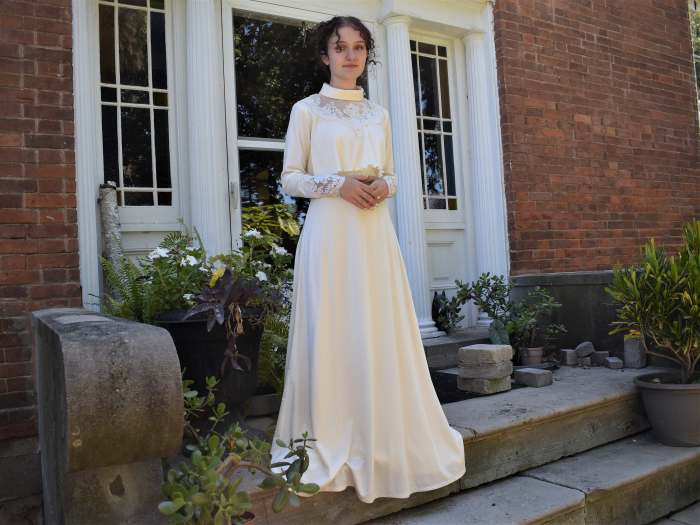
1970s Wedding Dress Styles
Wedding dresses of the 1970s – The 1970s witnessed a significant shift in wedding fashion, reflecting the era’s social and cultural changes. Gone were the restrictive styles of previous decades; the 70s embraced a more relaxed and individualized approach to bridal wear.
Styles and Silhouettes of 1970s Wedding Dresses
Several dominant silhouettes defined 1970s wedding gowns. The A-line, flattering on various body types, remained popular, offering a balance between formality and ease. Empire waistlines, emphasizing a high waistline and flowing skirt, created a romantic and ethereal look. Sheath dresses, offering a sleek and sophisticated silhouette, provided a more modern alternative. Necklines varied widely, from the elegant bateau and sweetheart necklines to the more daring halter neck.
Sleeve styles ranged from long sleeves, often bell-shaped or puffed, to sleeveless designs, reflecting the diversity of the decade’s aesthetic.
| Silhouette | Neckline | Fabric | Aesthetic |
|---|---|---|---|
| A-line | Sweetheart | Satin | Classic and romantic |
| Empire Waist | Bateau | Lace | Romantic and ethereal |
| Sheath | Halter | Crepe | Modern and sophisticated |
| Bell-sleeved A-line | Round | Chiffon | Bohemian and free-spirited |
Fabrics and Materials Used in 1970s Wedding Dresses
The fabrics chosen for 1970s wedding gowns significantly impacted the overall look and feel of the dress. Satin, with its luxurious sheen, was a popular choice, often used to create classic A-line or empire waist silhouettes. Lace, adding a touch of delicate femininity, was frequently incorporated, either as the primary fabric or as embellishments. Chiffon, with its light and airy quality, was ideal for creating flowing bohemian styles.
Crepe, offering a more structured and modern feel, was also a common choice. Beading, embroidery, and lace appliqués were used extensively to add texture and detail, reflecting the era’s penchant for embellishment.
Visual Representation of a 1970s Wedding Dress: Imagine a flowing A-line gown crafted from ivory chiffon. The fabric drapes softly over the body, creating a sense of effortless elegance. Delicate lace appliqués adorn the bodice, adding a touch of texture and visual interest. The overall effect is one of romantic bohemian charm.
Influence of Social and Cultural Trends

Source: etsystatic.com
The social and political climate of the 1970s profoundly influenced wedding dress styles. The women’s liberation movement encouraged a shift towards more comfortable and less restrictive clothing, impacting bridal fashion by allowing for a wider range of silhouettes and styles. The bohemian and hippie subcultures also left their mark, influencing the adoption of flowing fabrics, unconventional necklines, and less structured designs.
This resulted in a diverse range of wedding dresses, reflecting the individuality and self-expression that characterized the era.
A 1970s wedding dress exemplifying the bohemian trend might feature a flowing maxi dress made of crocheted cotton, adorned with floral embroidery and bell sleeves. This reflects the free-spirited nature and relaxed aesthetic of the time.
Iconic 1970s Wedding Dresses and Designers, Wedding dresses of the 1970s
Several iconic 1970s wedding dresses stand out for their unique designs and lasting influence. While specific designer attributions for many dresses from this era are difficult to definitively source, certain styles and silhouettes remain iconic.
- Dress 1: A flowing A-line gown in ivory satin with a plunging neckline and long bell sleeves. Key features include the luxurious fabric, the romantic silhouette, and the dramatic sleeves.
- Dress 2: A simple sheath dress in cream crepe, featuring a high neckline and minimal embellishment. This dress exemplifies the era’s move towards streamlined elegance.
- Dress 3: An empire waist gown in embroidered lace, with a fitted bodice and a flowing skirt.
1970s wedding dresses often showcased a bohemian flair, with flowing fabrics and relaxed silhouettes. For brides seeking a more modest approach, the styles available today offer a beautiful alternative, such as those found at wedding dresses modest vintage websites. These modern interpretations often draw inspiration from the elegance and simplicity of 70s designs, creating a timeless look.
This style reflects the romantic and ethereal aesthetic often associated with 70s bridal fashion.
The Evolution of the 1970s Wedding Dress into Later Styles
The influence of 1970s wedding dress styles can be traced through subsequent decades. Elements like flowing silhouettes, romantic lace, and bohemian detailing continue to appear in contemporary designs. The relaxed and individualistic spirit of the 70s has paved the way for more diverse and personalized bridal styles.
Evolution of Sleeve Styles:
- 1970s: Bell sleeves, long sleeves, puffed sleeves, sleeveless.
- 1980s: Puffed sleeves, off-the-shoulder sleeves, long sleeves with shoulder pads.
- 1990s: Spaghetti straps, cap sleeves, sleeveless, long sleeves.
- 2000s – Present: A wide variety of sleeve styles, including off-the-shoulder, long sleeves, three-quarter sleeves, and illusion sleeves, reflecting a diverse range of aesthetics and trends.
Commonly Asked Questions: Wedding Dresses Of The 1970s
Were there any specific colors popular for 1970s wedding dresses besides white?
While white remained the dominant color, ivory, cream, and even pastel shades like blush pink and light yellow gained popularity, reflecting the era’s more relaxed approach to tradition.
How did the availability of fabrics affect 1970s wedding dress designs?
The availability and cost of fabrics influenced design choices. More readily available materials like polyester were sometimes used, alongside more luxurious options like silk and lace, creating a range of price points and aesthetics.
Were there any significant designers who specialized in 1970s wedding dresses?
While specific designers dedicated solely to bridal wear weren’t as prominent as today, many high-fashion designers of the era incorporated bridal styles into their collections, influencing the overall aesthetic.